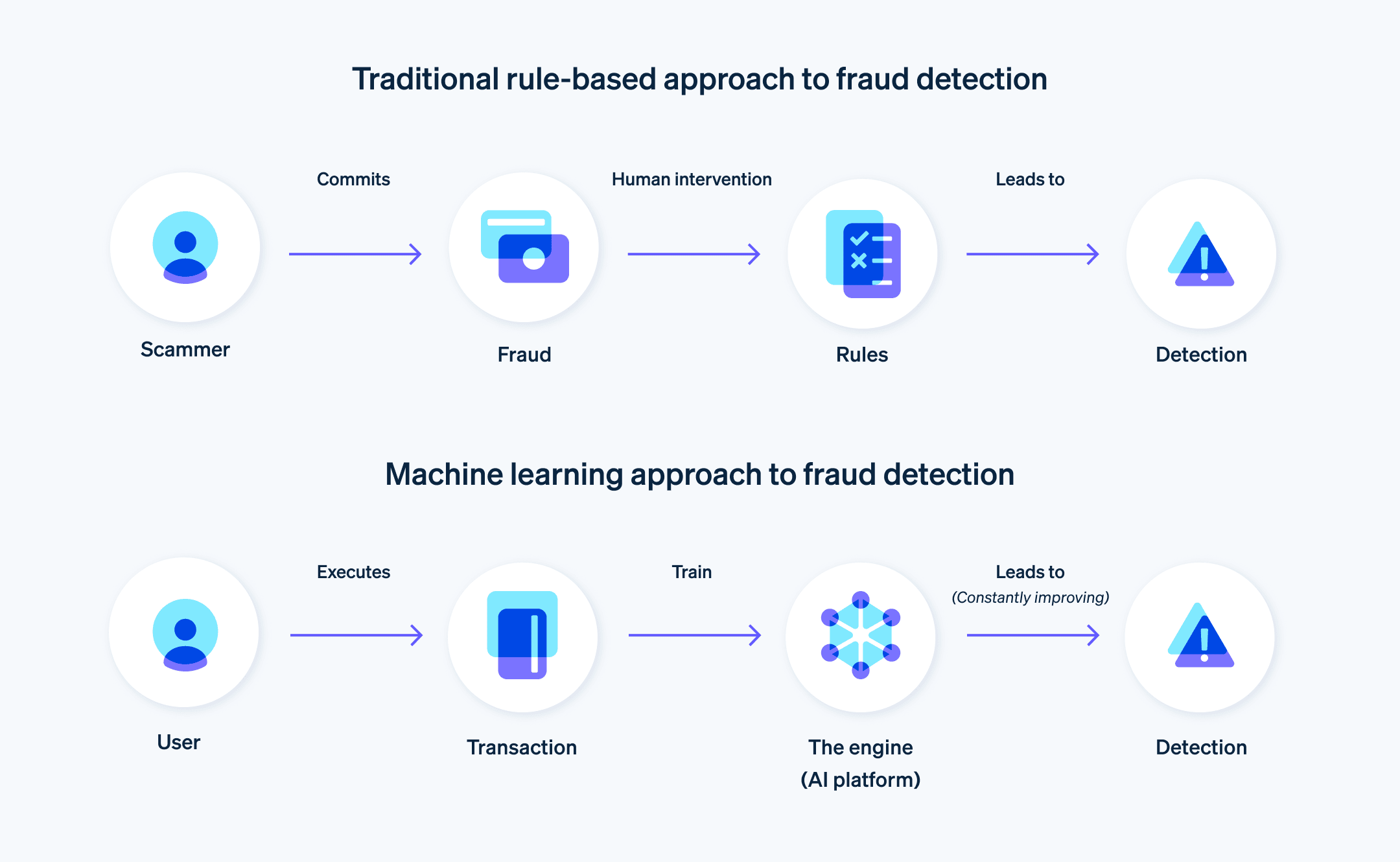2022 年,全球线上付款欺诈损失 达 410 亿美元,预计到 2023 年底,这一数字将激增至 480 亿美元。打击支付欺诈并减轻其破坏性的财务和声誉损失已成为企业的当务之急。除了支付欺诈带来的直接经济损失外,企业还面临着客户信任度和忠诚度的潜在削弱,以及监管机构和执法机构日益严格的审查。为了应对这一日益严重的威胁,组织正在求助于机器学习。
机器学习是人工智能 (AI) 的一个子领域,它提供了一种强大且适应性强的解决方案,以应对支付欺诈的复杂性和多变性。通过调动大型数据集和高级算法,机器学习可以识别表明欺诈行为的模式和异常,使企业能够实时检测和预防欺诈。最终,机器学习可以帮助企业维护安全的支付环境,以保护其客户、收入和声誉。
我们将介绍机器学习在预防欺诈方面的好处,以及企业如何在不同的支付场景中使用此工具。
目录
- 什么是机器学习?
- 机器学习如何用于欺诈预防和检测?
- 机器学习欺诈认证
- 用于欺诈检测的机器学习示例
解码 AI 支付创新:驱动营收增长的策略指南
了解如何使用人工智能优化从结账到争议处理的整个支付生命周期,从而帮助您增加收入、降低成本并提升客户体验。下载报告。
什么是机器学习?
机器学习是人工智能的一个子领域,专注于开发算法和模型,使计算机能够从数据中学习,从数据中识别模式,并根据其学习结果做出决策。
机器学习主要有三种类型:
监督式学习
监督式学习是一种机器学习,在这种学习方式中,计算机学会根据示例做出预测或决策。把它想象成学生向老师学习:老师为学生提供一系列问题和这些问题的正确答案,学生研究这些例子,学习识别模式。当学生面临新问题时,他们可以利用以前的知识找到正确的答案。
在监督式学习中,计算机算法被赋予一个包含输入数据(问题)和正确输出(答案)的数据集。该算法研究此数据集并学习输入和输出之间的关系。最终,该算法可以对以前从未见过的新数据做出预测或决策。
非监督式学习
非监督式学习是一种机器学习,在这种学习方式中,计算机学习识别数据的模式或结构,而无需给出任何具体示例或正确答案。这类似于侦探在没有任何初步线索的情况下尝试破案 — 从可用信息中寻找线索和联系,从而发现隐藏的模式或关系。在非监督式学习中,计算机算法被赋予一个仅包含输入数据的数据集,而没有任何相应的正确输出(答案)。算法的工作是分析这些数据并发现潜在的模式。
强化学习
强化学习是一种机器学习,在这种学习方式中,计算机通过与环境交互并以奖励或惩罚的形式接收反馈来学习做出决策。想想您是如何训练狗表演技巧的。当狗正确表演技巧时,您会给它吃点零食(奖励),当狗没有表演好技巧时,您可能会给它温暖的纠正(惩罚)。随着时间的流逝,狗学会了正确表演技巧,从而更大限度地增加它获得的零食数量。
在强化学习中,计算机算法(通常称为智能体)会探索环境并做出决策。每做出一个决定,它都会收到奖励或惩罚形式的反馈。该算法的目标是学习最佳策略或政策,以做出能在一段时间内使累积奖励最大化的决策。它通过试错来实现这一目标,并根据反馈调整和改进策略。
机器学习技术用于许多不同的场景,包括自然语言处理、图像和语音识别、医疗诊断、财务分析和自动驾驶汽车。
机器学习如何用于欺诈预防和检测?
机器学习越来越多地被用于欺诈预防和检测,因为它能够分析大量数据、识别模式和适应新信息。机器学习在欺诈预防中的一些常见应用包括:
异常检测
机器学习算法可以识别交易数据的异常模式或与正常行为的偏差。通过对历史数据进行“训练”,这些算法学会了识别合法交易并标记可能表明欺诈的可疑活动。风险评分
机器学习模型可以根据各种因素(例如交易金额、位置、频率和过往行为)为交易或用户账户分配风险评分。风险评分越高表明欺诈的可能性越高,使组织能够确定其资源的优先级,并专注于需要进一步调查的特定交易或账户。网络分析
诈骗分子经常合作并形成网络来开展活动。图形分析等机器学习技术可以通过分析实体(如用户、账户或设备)之间的关系并识别异常连接或集群来帮助发现这些网络。文本分析
机器学习算法可以分析非结构化文本数据,例如电子邮件、社交媒体帖子或客户评论,以识别可能表明欺诈或诈骗的模式或关键字。身份验证
机器学习模型可以分析和验证用户提供的信息,例如身份证件图像或面部识别数据,以确保个人是他们声称的身份并防止身份盗用。自适应学习
机器学习的主要优势之一是它能够学习和适应新信息。随着诈骗分子改变他们的手段,机器学习模型可以根据新数据进行重新训练,使他们能够保持最新状态,并更好地检测新出现的欺诈模式。
在欺诈预防中使用机器学习可以成为组织增强检测能力、降低误报风险以及改善整体安全性和客户体验的有效方法。

机器学习欺诈认证
机器学习欺诈认证是一种专注于机器学习技术在欺诈检测和预防中的应用的专业认证或培训计划。该认证的目标是为个人提供应用机器学习打击欺诈所需的知识、技能和工具。
机器学习欺诈认证计划通常涵盖:
机器学习基础:介绍机器学习的基本概念和原理,包括监督式学习、非监督式学习和强化学习技术,以及最常用的算法。
数据准备和预处理:用于清理、转换和准备用于机器学习模型的数据的技术,包括如何处理缺失或嘈杂的数据(损坏或无法使用的数据)、特征工程和数据规范化。
模型训练和评估:使用准确率、精确率、召回率和 F1 分数(精确率和召回率的度量)等指标训练机器学习模型、选择适当的算法、优化模型参数以及评估模型性能的方法。
欺诈检测技术:概述了欺诈检测中使用的各种基于机器学习的方法,例如异常检测、风险评分、网络分析、文本分析和身份验证。
实施和部署:在生产环境中实施和使用机器学习模型的最佳实践,包括模型版本控制、监视和维护一段时间内的模型表现。
道德和法规:讨论与机器学习和欺诈预防相关的道德考虑因素和法规遵从性,例如数据隐私、公平性和可解释性(能否向人类解释机器学习模型从输入到输出的过程)。
获得机器学习欺诈认证有助于专业人士展示他们在这一专业领域的专业知识,使其成为希望提高欺诈检测能力的组织的宝贵资产。有许多类型的专业人士可以从此类认证中受益,包括数据科学家、分析师、欺诈调查员和网络安全专家。
用于欺诈检测的机器学习示例
处理客户付款的企业可以针对不同的支付场景应用基于机器学习的欺诈检测和预防:
线下支付
信用卡欺诈检测
机器学习算法可以分析交易数据(例如时间、地点、金额和业务),以识别模式并实时标记潜在的欺诈性交易。例如,如果客户的银行卡在短时间内在两个相距遥远的地点使用过,系统可以将交易标记为可疑交易。销售点 (POS) 异常检测
机器学习可以监控 POS 交易并识别异常模式。例如,如果员工处理了异常多的退款或折扣,这可能表明内部欺诈或盗窃。
移动支付
设备指纹识别
机器学习模型可以分析特定于设备的信息(例如,设备型号、操作系统、IP 地址),为每个用户创建唯一的“指纹”。这有助于检测欺诈活动,例如账户盗用或关联到单个设备的多个账户。行为生物识别
机器学习可以分析用户行为模式,例如打字速度、滑动手势或应用使用情况,以验证用户的身份并检测任何可能表明存在欺诈的异常情况。
电商
防止账户盗用
机器学习可以监控用户登录模式并检测异常活动,例如多次失败的登录尝试或来自新设备或位置的登录尝试,这可能表明存在账户盗用尝试。非恶意欺诈检测
机器学习可以识别与非恶意欺诈相关的模式,在这种模式中,客户进行了购买,然后声称交易未经授权或他们从未收到过产品。模型可以分析客户购买记录、退货率和拒付模式等因素,以标记潜在的非恶意欺诈案例。
其他相关用例
发票欺诈检测
机器学习可以分析发票和相关文档,以识别可能表明存在欺诈的差异,例如重复发票、金额不一致或可疑的供应商详细信息。忠诚度计划欺诈检测
机器学习可以监控忠诚度计划中的客户行为,例如积分累积、兑换和账户活动,以识别和标记潜在的欺诈或滥用行为。
通过实施基于机器学习的欺诈检测和预防系统,企业可以更好地保护自己和客户免受欺诈,减少财务损失,并提高客户的信任度和满意度。
本文中的内容仅供一般信息和教育目的,不应被解释为法律或税务建议。Stripe 不保证或担保文章中信息的准确性、完整性、充分性或时效性。您应该寻求在您的司法管辖区获得执业许可的合格律师或会计师的建议,以就您的特定情况提供建议。
